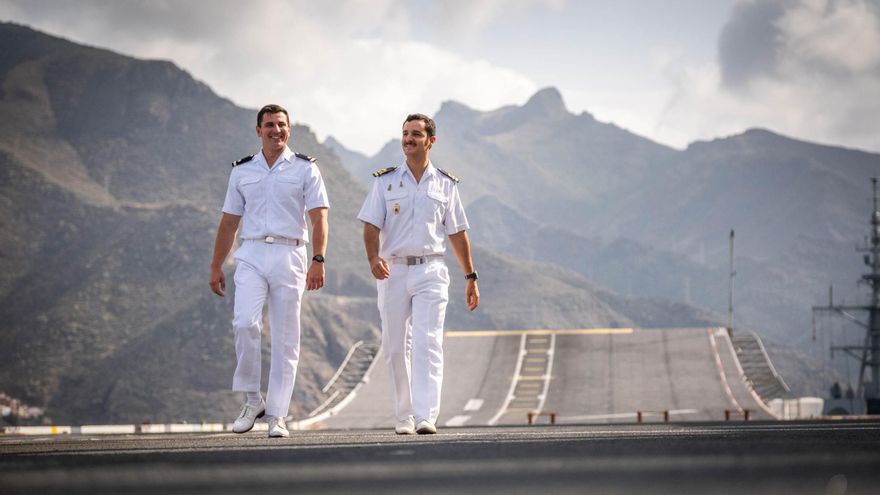
The largest and most expensive warship built by the Spanish Navy, costing 400 million euros, has opened its doors to the public at the Port of Santa Cruz de Tenerife, allowing them to discover its secrets, its impressive facilities, and the work of the sailors. The ship Juan Carlos I (L-61) is part of the Naval Presence which the capital, Santa Cruz, is hosting this week for the celebration of Armed Forces Day (Difas), with the central event, presided over by the Kings, taking place on Saturday on the Avenida de La Constitución. The warship, which provided humanitarian aid in the earthquake in Turkey and the Dana tragedy in Valencia, among other numerous missions, can be visited until next Sunday in Santa Cruz. A tour of this impressive vessel, built in 2010 and based in Rota (Cádiz), allows visitors to learn about the features that make it the flagship of the Spanish Navy, as well as the work of its crew. “We are delighted for visitors to come, so we can explain to the public what we do. Our main work is conducted at sea, so this is a great opportunity to bring our work closer to the citizens,” says Lieutenant Guillermo Novillo-Fertrell.
Aircraft Carrier
He explains that the Juan Carlos I, whose NATO designation is LHD (Landing Helicopter Dock), is a multipurpose ship “with amphibious and aircraft carrier capabilities.” It can transport and operate up to thirty aircraft, including planes and helicopters, as well as about one hundred vehicles, such as battle tanks. For the celebration of Armed Forces Day in Santa Cruz, this ship has transported five planes and three helicopters, as well as about 50 vehicles.
Functions
Among the functions of the Juan Carlos I, according to the lieutenant, is the transport, in relation to its amphibious capability, of the Marine Infantry Forces to conduct landings, supporting operations on land; the transportation, as a force projection ship, of any army to an operational center; and the transport of planes and helicopters, as well as the pilots and all the necessary equipment, so they can operate from the ship, which has a 200-meter takeoff and landing strip, as well as the corresponding control tower. Additionally, another mission of this impressive vessel is “non-combat” operations, meaning humanitarian aid, evacuation of personnel from crisis areas, and hospital ship in disaster-affected zones.
Like one of Madrid’s towers
This ship, weighing 26,000 tons, is 237 meters long, 32 meters wide, and 40 meters high. “To give citizens an idea, if we put it vertically, its size is comparable to one of the Four Towers of Madrid,” says Novillo-Fertrell.
How many people?
It can transport up to about 1,400 people; “it’s a floating city.” Specifically, its crew, which also includes Canarians, consists of 300 military personnel, including officers, non-commissioned officers, first corporals, corporals, and sailors. 15% are women. “Currently, we have about 800 military personnel on the ship.”
How many days at sea?
According to Ensign Ignacio Moreno, the Juan Carlos I has 75 cabins for the officers. The rest of the crew and the military personnel transported on various missions share rooms, where they sleep in bunks. Normally, missions last an average of between 15 and 35 days, during which the sailors remain at sea. This ship, with a height of forty meters, provided humanitarian aid during the Dana tragedy in Valencia.
Waves of seven meters
During the trips to attend different assigned missions, they face all kinds of adverse weather conditions, to which they are accustomed. “We have had to overcome waves of up to seven meters, but this ship is completely safe,” affirms Lieutenant Guillermo Novillo-Fertrell.
Missile Launch
He says that since 2023, the Juan Carlos I has been deployed in the Mediterranean Sea and also in the Baltic Sea. At the beginning of that year, it provided humanitarian aid due to the earthquake in Turkey, as Turkish authorities requested support. At the end of 2024, that aid was transferred to Valencia due to the Dana tragedy. After participating in the Armed Forces Day commemorations in Santa Cruz de Tenerife, the Juan Carlos I will continue its duty, setting sail for the Mediterranean. The next assigned mission consists of conducting “missile launch exercises and target sinking training.”
The life of a sailor
The lieutenant says that the life of a sailor involves facing a personal challenge every day, “with the goal of overcoming it, as we are far from home.” He notes that without family support, the situation would be much harder. “Our work is tough, but we also have the opportunity to visit many places, cultures, and people.” Among the most challenging missions faced, Guillermo Novillo-Fertrell highlights the one related to the Dana tragedy in Valencia. “Many compatriots lost everything, and it was really difficult.”
Visiting hours
Residents and visitors will have the opportunity in the coming days to discover the secrets of the largest warship built in Spain, which is docked at the Port of Santa Cruz. It can be visited on Saturday, from 15:00 to 20:00, and on Sunday, from 10:00 to 14:00.
















